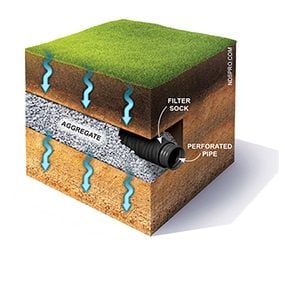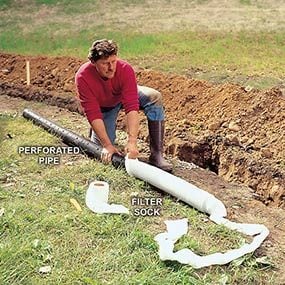Im new at all this. If I dig a 30 ft long trench, which is the length of the standing water problem in my front yard, and install a slotted pipe that will allow water to seep inside it, where does the water go? I dont want to go to the trouble of tying it in to other drains I have so that it will flow out of the yard. I was hoping to dig the trench, lay the gravel and pipe, and cover it up and be done with it. Am I oversimplifying things?

Todd C
Where does the water that is collected by a french drain go?
1 reading
Todd C
Discussion starter
2 posts
·
Joined 2019
- Add to quote Only show this user
Im new at all this. If I dig a 30 ft long trench, which is the length of the standing water problem in my front yard, and install a slotted pipe that will allow water to seep inside it, where does the water go? I dont want to go to the trouble of tying it in to other drains I have so that it will flow out of the yard. I was hoping to dig the trench, lay the gravel and pipe, and cover it up and be done with it. Am I oversimplifying things?
481 posts
·
Joined 2016
I would go to the lowest spot and dig a post hole. Nothing fancy, dig down
until you hit good sand,( 3 or 4ft at my house)Back fill the hole with stones. See if that helps. You might need to run your pipe but getting a spot you
know should drain would be a good start.
until you hit good sand,( 3 or 4ft at my house)Back fill the hole with stones. See if that helps. You might need to run your pipe but getting a spot you
know should drain would be a good start.
1,126 posts
·
Joined 2018
I don’t think your over simplifying. I would also use a pipe sleeve cover. The point is to help the water drain more uniformly along the pipe length to help dissipate the puddling water. Exit drains are necessary if the uniform leaching doesn’t work.
1,904 posts
·
Joined 2019
A French drain isn’t magic. If you had enough of it it might serve as a leach field but it needs to drain to daylight.
21,762 posts
·
Joined 2008
Uh yea
It's got to go to either "day light" - meaning down hill there a trench/ stream
Or other form of depositing out let
Or you need to dig a drywell for it to go to
It's got to go to either "day light" - meaning down hill there a trench/ stream
Or other form of depositing out let
Or you need to dig a drywell for it to go to
Todd C
Discussion starter
2 posts
·
Joined 2019
Thank you all for your replys...........here is the story I read that made me think that a french drain does not have to have an outlet.
Install a French Drain
A French drain is a versatile system for dealing with all kinds of drainage problems. It disperses water over a large area through a buried perforated pipe. The pipe must be surrounded by material that allows water to drain through. Conventionally this was gravel, but NDS sells a system called EZflow that includes the pipe and surrounding polystyrene aggregate in one convenient and lightweight package. A French drain system can be used alone or combined with a dry well.
A properly designed French drain system does not require an outlet. The water will simply soak into the soil as it flows along the perforated pipe. In fact, a French drain doesn't require an inlet on just one end either. You can construct the drain to accept water along its length, and disperse it underground.
![Image]()
![Image]()
Anatomy of a French Drain: A typical French drain consists of a perforated pipe-usually flexible lightweight plastic-sheathed by a fabric sock to keep dirt and sand from clogging the pipe. The pipe is buried in a trench and surrounded by aggregate. Water enters the pipe, from an inlet at one end, through the earth, or through long narrow grates spaced along its length, and is dispersed through the aggregate and into the ground.
Install the Pipe in a Trench: Connect the lengths of tubing and place them over a bed of gravel. Then add gravel on the sides and over the top before covering the pipe. Perforated drainage pipe is also available with the sock in place.
Install a French Drain
A French drain is a versatile system for dealing with all kinds of drainage problems. It disperses water over a large area through a buried perforated pipe. The pipe must be surrounded by material that allows water to drain through. Conventionally this was gravel, but NDS sells a system called EZflow that includes the pipe and surrounding polystyrene aggregate in one convenient and lightweight package. A French drain system can be used alone or combined with a dry well.
A properly designed French drain system does not require an outlet. The water will simply soak into the soil as it flows along the perforated pipe. In fact, a French drain doesn't require an inlet on just one end either. You can construct the drain to accept water along its length, and disperse it underground.


Anatomy of a French Drain: A typical French drain consists of a perforated pipe-usually flexible lightweight plastic-sheathed by a fabric sock to keep dirt and sand from clogging the pipe. The pipe is buried in a trench and surrounded by aggregate. Water enters the pipe, from an inlet at one end, through the earth, or through long narrow grates spaced along its length, and is dispersed through the aggregate and into the ground.
Install the Pipe in a Trench: Connect the lengths of tubing and place them over a bed of gravel. Then add gravel on the sides and over the top before covering the pipe. Perforated drainage pipe is also available with the sock in place.
912 posts
·
Joined 2010
Yes this is true. Its perforated, so as water enters the perforations and runs down hill it will exit the perforations as long as the soil accepts it. To much water and it keeps going down the pipe untill it can exit, unless your pipe isnt long enough then u wasted your time. Most people run perforated pipe to a primary outlet though.
1,433 posts
·
Joined 2017
Either you can send it out to another part of the lawn with a popup or run it longer and have it leech out with a perforated pipe.
1 post
·
Joined 2025
You're not alone in thinking it could be as simple as digging, laying pipe, and covering it but unfortunately, you're right to suspect it might be a bit more complex. A French drain needs a place for the water to go, otherwise it just relocates the problem underground and can eventually lead to saturation or even flooding in unexpected areas.
If your property has a slope, you might be able to daylight the pipe at the end of the trench, basically letting gravity do the work and sending the water to a lower point where it can safely disperse. But if your yard is flat or boxed in, it gets trickier. In some setups, people connect the drain to an existing stormwater system or even install a dry well to allow for gradual seepage.
In Singapore, for example, where yard drainage issues can be a big concern during heavy rains, it’s common to consult with professionals to ensure the system has proper exit routes. When I was dealing with a similar issue, I spoke to Plumber Singapore, and they helped me understand the flow requirements so I didn’t end up creating a hidden mess under my lawn.
If you're considering a DIY route, it’s worth at least checking out some guides or speaking to a local expert. For more info on how water systems work in different property setups, their website has useful resources that can give you some clarity, even if you’re just looking to troubleshoot on your own for now.
Hope that helps!
If your property has a slope, you might be able to daylight the pipe at the end of the trench, basically letting gravity do the work and sending the water to a lower point where it can safely disperse. But if your yard is flat or boxed in, it gets trickier. In some setups, people connect the drain to an existing stormwater system or even install a dry well to allow for gradual seepage.
In Singapore, for example, where yard drainage issues can be a big concern during heavy rains, it’s common to consult with professionals to ensure the system has proper exit routes. When I was dealing with a similar issue, I spoke to Plumber Singapore, and they helped me understand the flow requirements so I didn’t end up creating a hidden mess under my lawn.
If you're considering a DIY route, it’s worth at least checking out some guides or speaking to a local expert. For more info on how water systems work in different property setups, their website has useful resources that can give you some clarity, even if you’re just looking to troubleshoot on your own for now.
Hope that helps!
-
?
-
?
-
?
-
?
-
?
-
?
-
?
-
?
-
?
-
?
-
?
-
?
-
?
-
?
-
?
-
?
-
?
-
?
-
?
-
?
- posts
- 7.2M
- members
- 230K
- Since
- 1999
A forum community dedicated to lawn care and landscaping professionals and enthusiasts. Come join the discussion about performance, modifications, classifieds, troubleshooting, maintenance, and more!
Top Contributors this Month
View All
hort101
226 Replies
ForaFrank
160 Replies
Mark Oomkes
159 Replies



